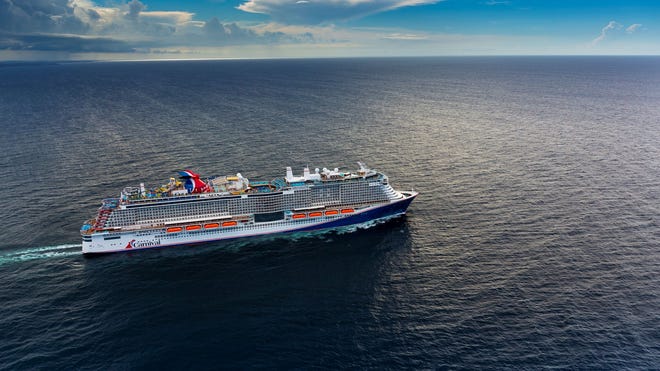- Wi-Fi is a standard offering on cruise ships these days, and the quality has greatly improved in recent years.
- Cruise mobile phone service allows guests to continue using their cell phones much as they would on land – with some key distinctions.
- Travelers may have used foreign SIMs – the card that allows cellular networks to identify owner information – or eSIMs as fewer phones have physical SIM slots to get around roaming fees.
Get more news like this delivered to your inbox bysigning up for our Travel newsletter here.
I spent more than a week on an Antarctica cruise last winter walking alongside penguins, watching whales and sailing by icebergs. But one of the most jaw-dropping moments was when I uploaded Instagram Stories from the Aurora Expeditions ship thanks to shockingly fast Wi-Fi.
Modern technology allows passengers to stay connected in places they may never have expected. And while some travelers take a cruise to leave their day-to-day behind, keeping in touch with folks back on land is vital for others.
But Wi-Fi isn’t the only way to do that. Here’s what to know.
Do cruise ships have Wi-Fi?
Wi-Fi is a standard offering on cruise ships these days, and the quality has greatly improved in recent years. At one time, it was common for the internet to be slow, bump users off or go out entirely, according to Theresa Scalzitti, chief operations officer at Cruise Planners.
“It was a lot of, like, ‘Let me walk around the ship and see where I’ve got some good service,’ ” Scalzitti said. That began to change when many cruise lines equipped ships with SpaceX’s Starlink.
Carnival Corp., which owns Carnival Cruise Line, Princess Cruises, Holland America Line and more announced in May that installation was complete across its entire fleet. Other companies like Royal Caribbean Group have shared similar plans.
Wi-Fi is typically offered in packages with multiple tiers.
Carnival, for example, has three options:
◾ The Social Wi-Fi Plan costs $15.30 per person, per day for access to social media like Instagram and Facebook and major airline websites.
◾ The Value Wi-Fi Plan offers sites included in the Social plan at a quicker speed, along with email and additional browsing, for $19.55.
◾ The Premium Wi-Fi plan is up to three times faster than the other plans and allows users to video chat, stream movies, and more for $21.25.
Norwegian Cruise Line, meanwhile, has two options. The Unlimited Wi-Fi Package offers web browsing, email and messaging for one device for $29.99 per day, while the Unlimited Premium Wi-Fi Package includes video and audio streaming for $39.99. Guests can also add more devices for an extra charge.
Scalzitti said whether or not to purchase Wi-Fi is a “very personal decision” depending on a traveler’s priorities. For those who plan to work remotely, for instance, it may be a must-have. Others may opt to turn it off while in transit and reconnect in port to save money.

Can I get cell service on cruise ships?
Yes, believe it or not. Like Wi-Fi, cruise mobile phone service allows guests to continue using their cellphones much as they would on land – with some key distinctions.
WMS, a major provider, builds cellular networks on cruise ships. Its Cellular at Sea service operates over a satellite connection so users can make phone calls, browse the internet and send and receive messages – including SMS.
That makes it a better choice for passengers who want to text between Androids and iPhones, which show up in green rather than blue. “That would not work on Wi-Fi,” said Pramod Arora, president and CEO of WMS.
Travelers may also be able to use the Wi-Fi calling feature on their phones to make calls, but Arora said those are less secure and of typically of lower quality than the ones made via cellular.
The company has roaming agreements with 400 cellular carriers worldwide, which are accessible from 200 cruise ships across 25 cruise lines. In those cases, travelers’ devices will automatically connect to the network when the vessel gets far enough away from land – as long as roaming is enabled and airplane mode is off.
The specifics of the plans and pricing vary. Verizon, for example, offers a $30 Cruise Daily Pass that includes 50 minutes of calls, unlimited texts and 0.5 gigabytes of data (with an overage charge of $1.99 per minute) during a 24-hour period. The pass only covers users on board the ship, though, so they’ll be charged applicable rates in countries where they disembark.
Passengers can sign up for the service through their mobile carrier before or during their cruise, though it’s worth researching the options in advance.
Guests who plan to use their devices a lot, particularly for “data-centric” activities like watching YouTube videos or Netflix, may be better off opting for Wi-Fi, Arora said.

Can I work remotely from a cruise?:Here’s what it was like
Can I use a foreign SIM or eSIM on a cruise?
Travelers may have used foreign SIMs – the card that allows cellular networks to identify owner information – or eSIMs as fewer phones have physical SIM slots to get around roaming fees. WMS offers a data-only eSIM option for users whose carriers don’t have a roaming agreement in place, which they can also use on land.
That said, there may not be as much difference in cost as there once was as cellular providers have moved to a more economical day-pass model for international coverage. “If you can get to a $10, $15, $20-a-day charge and you can get that from your home provider, well, the eSIM providers have to match that if they want to compete, right?” Arora said.
Nathan Diller is a consumer travel reporter for USA TODAY based in Nashville. You can reach him at [email protected].
